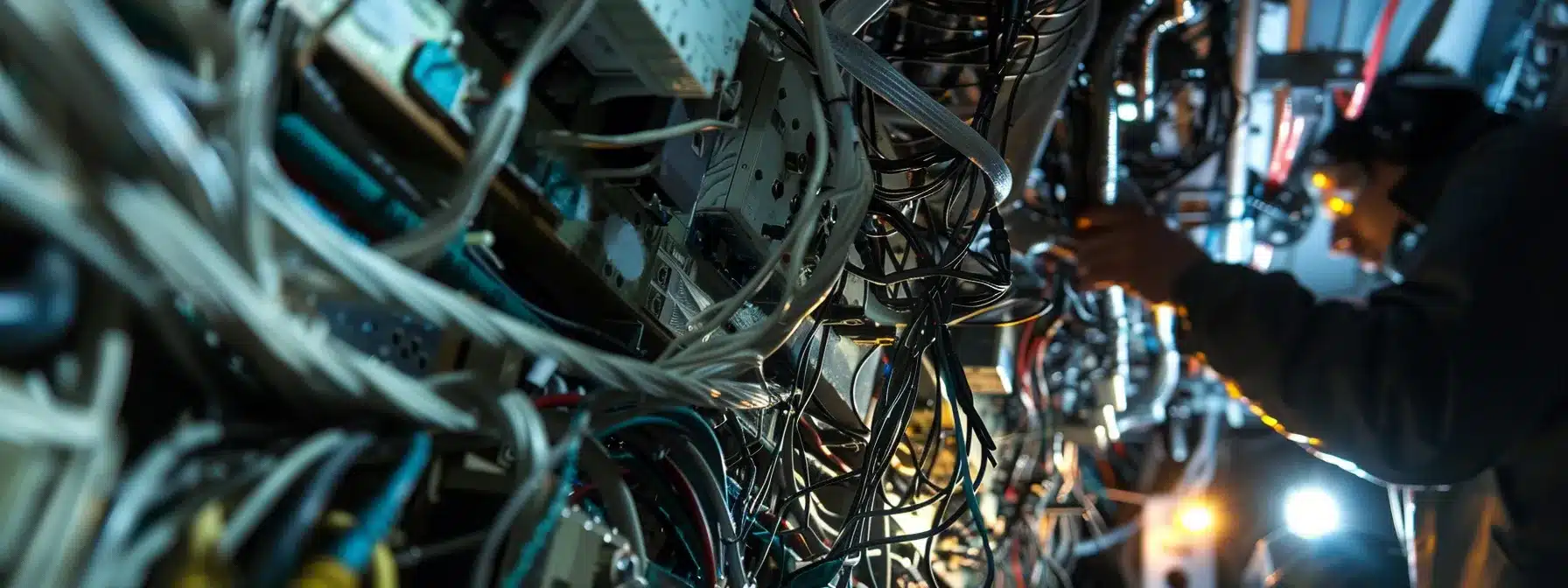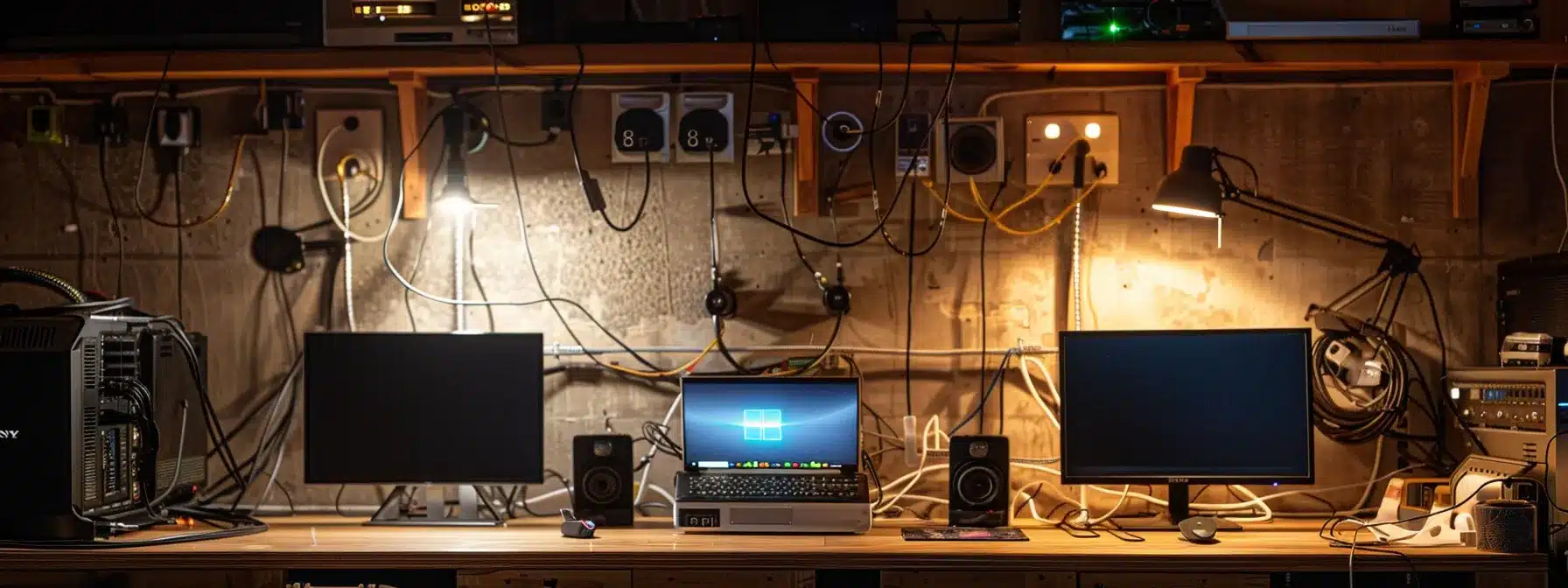Circuit breakers play a crucial role in protecting homes and businesses from electrical failures. They can trip for various reasons, and understanding these causes—like overloaded circuits, corrosion from moisture, or even issues related to refrigerant systems—can save homeowners a headache. Sometimes, factors such as flooding can worsen these situations, leading to dangerous failures. There’s more to these trips than meets the eye, and knowing the main culprits can help prevent future problems. Keep reading to learn about the key reasons behind circuit breaker trips and how to keep your electrical system running smoothly!
Key Takeaways
- circuit overloads are a common cause of tripped breakers, requiring careful electrical load management
- short circuits can result from damaged wiring, emphasizing the need for regular electrical inspections
- ground faults occur when live wires contact the ground, often due to moisture or wear
- keeping track of appliance power needs helps prevent overloads and enhances home electrical safety
- upgrading circuit breakers to modern models improves safety and efficiency against electrical hazards
The Main Culprits Behind Circuit Breaker Trips

When it comes to circuit breakers tripping, several common culprits often come into play. Circuit overloads are a leading cause, where too many devices draw more power than the system can handle, resulting in a potential hazard and a quick trip. Short circuits also play a significant role; these occur when electrical wires come into contact with each other, typically due to worn insulation or improper installation, violating national electrical code standards. Ground faults add another layer to the issue, as they happen when a live wire touches the ground, leading to immediate circuit interruption. Understanding these causes can help homeowners and businesses in Lexington, KY make more informed choices about their electrical services and reduce the risk of unexpected power outages.
Circuit Overloads Explained
When a circuit breaker trips due to overload, it’s usually because too many devices are drawing power from the same circuit. Each circuit has a limit to how much power it can supply safely, and exceeding that limit can lead to issues like overheating or even fires. Homeowners need to be aware of how their power supply is being used to prevent this from happening. It’s essential to know when to seek help from an emergency electrician.
In addition to the immediate risk of a tripped breaker, overloads can create dangerous conditions such as arc faults. An arc fault occurs when electrical current jumps from one conductor to another, which can generate enough heat to ignite nearby materials. Ensuring circuits are well-balanced can reduce the chance of a leak or arc flash events that put homes and businesses at risk.
To avoid tripping a circuit breaker, it’s wise to consider the overall capacity of the electrical system. Managing the load by spreading out high-demand devices across multiple circuits can maintain a steady power supply and enhance safety. Regular inspections by licensed electricians can help identify potential overload scenarios and keep everyone’s electrical system running smoothly.
The Role of Short Circuits in Tripping Breakers
Short circuits are a major factor when it comes to tripping circuit breakers. They happen when a live wire accidentally connects with either a ground wire or another wire, allowing a surge of electricity to flow through, often leading to very high voltage levels. This sudden spike can make electrical systems dangerously hot, prompting breakers to trip as a safety measure.
As homes and businesses age, wear and tear on wiring can increase the risk of short circuits. For instance, if someone connects a hot tub without ensuring the wiring is up to code, they invite trouble. Regular checks by a qualified electrician can identify vulnerabilities and help maintain a safe electrical environment.
Addressing potential short circuits is essential for overall safety, especially in spaces where water and electricity meet, like around a hot tub. If a short circuit occurs, not only can it lead to power interruptions, but it can also create hazardous conditions, such as electrical fires. Keeping up with routine maintenance and consultations can help prevent these serious issues from developing.
How Ground Faults Contribute to the Issue
Ground faults can be a tricky issue in any electrical system. They occur when a live wire unintentionally makes contact with the ground or any water source, often due to moisture present in areas like kitchens and bathrooms. This contact can create a surge of electricity, potentially leading to overcurrent situations that cause the breaker to trip and cut off power.
In places where equipment like compressors operate, ground faults can spell trouble. If moisture infiltrates the wiring, it raises the risk of shorts or faults significantly. Regular inspection of the electrical system is critical to catch these vulnerabilities before they become serious hazards, especially in homes and businesses located in high-humidity areas.
Understanding ground faults is vital for safety, particularly for those living and working in areas with specific zip codes prone to weather-related moisture issues. Homeowners should remember that neglecting these inspections can lead to costly repairs down the road and possibly jeopardize electrical safety.
- Ground faults happen when a live wire connects with the ground.
- Moisture can contribute to this dangerous connection.
- Overcurrent situations can lead to circuit breaker trips.
- Regular inspection can help prevent these faults.
- Areas with compressors are especially at risk.
Understanding why circuit breakers trip can save you time and money. Let’s jump right into what triggers these electrical interruptions!
Dive Into What Causes a Circuit Breaker to Trip

Understanding why circuit breakers trip is crucial for homeowners and business owners alike. Knowing how these devices function can help in troubleshooting issues that may arise. Common signs like flickering lighting or devices repeatedly turning off may suggest an overloaded circuit. It’s also important to be aware of how to spot the signs of a short circuit, such as an unusual smell or visible damage to metal wiring. Ground faults, often caused by moisture or faulty equipment, can lead to dangerous overheating, putting properties at risk. Utilizing tools like surge protectors can mitigate some of this risk, but regular inspections and maintenance always play a major role in keeping electrical systems safe and functional.
The Basics of Circuit Breaker Functionality
Circuit breakers serve as the first line of defense in electrical systems, designed to protect homes and businesses from excess current. Much like a fuse, they act by interrupting the flow of electricity when they detect an overload or fault, preventing potential hazards. These devices monitor the wires in the system, ensuring that everything runs smoothly without unexpected spikes in power.
When electricity flows normally, the circuit breaker remains closed, allowing power to reach appliances and systems, including HVAC systems. However, if the wires become damaged or if there’s a ground fault, the breaker will trip, cutting off the current and averting more serious issues like electrical fires. The presence of an insulator around the wires ensures that energy flows where it’s needed while keeping away from surfaces that may cause short circuits.
For proper functionality, it’s critical to understand how circuit breakers interact within the electrical system. They continuously check for any irregularities and respond instantly if they detect something amiss. This immediate reaction helps protect not only the equipment but also the safety of everyone in the building, ensuring a reliable power supply while maintaining safety standards.
Identifying Signs of an Overloaded Circuit
Recognizing the signs of an overloaded circuit is key for homeowners. If a light switch frequently flickers or struggles to power devices, it could indicate too much electric current is flowing through the electrical wiring. This is a clear warning sign that an inspection is needed to avoid potential hazards.
Another visible sign is the warmth around outlets or switches, which can hint at an overload situation. If a homeowner notices that the outlets feel hot or have a burnt smell, it’s time to cut off the power and address the wiring. Ignoring these signs could void warranties on appliances or lead to costly repairs.
Additionally, tripping circuit breakers on a regular basis can also signal trouble. If this happens after plugging in a new device, it’s smart to check the power load. Keeping a checklist of appliances and their power needs can help avoid overloads and maintain safe electrical usage:
- Check for flickering lights or struggling devices.
- Be aware of warmth around switches and outlets.
- Listen for unusual noises when devices run.
- Note when breakers trip after new devices are added.
- Keep track of electric current needs for appliances.
Spotting the Signs of a Short Circuit
Spotting signs of a short circuit is essential to prevent serious electrical faults that can lead to dangerous situations. Homeowners should be alert to abnormal behaviors like flickering lights or appliances that suddenly stop working. These oddities can suggest a disruption in the flow of energy, indicating a potential short circuit that warrants immediate attention.
Another red flag to watch for is overheating around outlets or devices, especially those using a heating element. If any outlet feels excessively warm or emits a burning smell, it’s important to take action right away. Such conditions not only signal possible electrical damage but also heighten the risk of electrical fires.
Additionally, unusual sounds coming from electrical appliances or outlets can indicate a short circuit. Hissing or buzzing noises should alert homeowners to potential issues needing immediate inspection. Staying vigilant helps maintain electrical safety and can save money in the long run by preventing costly repairs:
- Watch for flickering lights or sudden device failures.
- Check outlets for overheating or burning smells.
- Listen for unusual sounds from appliances or outlets.
Understanding Ground Faults and Their Impact
Ground faults can occur in various settings, particularly in homes with high electrical loads such as air conditioning systems. When a live wire touches a grounded surface, it creates a potentially hazardous situation. Homeowners need to keep an eye on junction boxes as any moisture or wear in that area can elevate the risk of a ground fault.
These faults can lead to serious issues, including tripped circuit breakers and sometimes even short circuits. If the electrical load exceeds what the circuit can handle, it’s more likely that the system will shut down to prevent damage. Staying informed about how these features work can help in preventing dangerous situations.
Now that the reasons behind a tripped circuit breaker are clear, let’s tackle how to keep those pesky trips from happening in the first place. With the right precautions, homeowners can enjoy a hassle-free electrical system!
How to Prevent Frequent Circuit Breaker Trips

Preventing frequent circuit breaker trips is essential for both fire safety and maintaining efficient electrical functionality in the home. Managing the electrical load effectively can reduce risks, especially in high-usage areas like bathrooms. Homeowners should consider regular inspections of their systems to catch potential issues early, helping to avoid electrical injuries caused by faulty wiring or equipment. Upgrading circuit breakers to more efficient models can also improve overall safety and performance, especially in regions prone to lightning strikes. By staying proactive and attentive to these aspects, families can create a safer living environment while keeping their electrical systems running smoothly.
Tips for Managing Your Home’s Electrical Load
Managing a home’s electrical load starts with understanding how much electric charge each device uses. Homeowners should experiment with the placement of high-energy appliances like dishwashers, ensuring they aren’t all on the same circuit. This simple shift can prevent overloads and allow for a more balanced flow of electricity throughout the home.
It’s critical to pay attention to how many appliances run simultaneously, especially those that draw significant power. For example, using the washer and dryer while running the dishwasher may create an excessive electric load, leaving the circuit vulnerable. By being mindful of this, families can vastly reduce the risk of injury caused by tripped breakers and potential electrical hazards.
The Importance of Regular Electrical Inspections
Regular electrical inspections are crucial for maintaining a safe and efficient home environment. Homeowners in Lexington, KY, especially those engaged in home improvement or construction projects, should prioritize these checks to catch potential issues early on. With a quick press of a button, they can schedule inspections that may save them from costly repairs down the line.
Having licensed electricians inspect the electrical system ensures everything is up to code and functioning properly. These professionals can identify problems that might not be obvious, like worn-out wires or overloaded circuits, which can lead to circuit breaker trips. A proactive approach to electrical safety not only protects homes but also enhances overall energy efficiency.
Investing in regular inspections supports long-term home safety and performance. When electrical systems are functioning correctly, families can go about their daily lives without worrying about unexpected outages or hazards. Ultimately, staying ahead of potential issues gives homeowners peace of mind, knowing their homes are secure from electrical dangers.
Upgrading Your Circuit Breakers for Greater Efficiency
Upgrading circuit breakers can significantly enhance a home’s electrical efficiency and safety. Newer models offer better protection against overloads and can handle increased electrical demands, ensuring the entire system runs smoothly. Homeowners benefit not only from improved safety but also from reduced risk of frequent trips and potential damage to appliances.
These modern breakers often come equipped with features like ground fault circuit interrupters (GFCIs) and arc fault circuit interrupters (AFCIs) that provide an additional layer of protection. By interrupting the flow of electricity when they detect problems, these devices help prevent dangerous situations before they escalate. This makes upgrading not just a smart choice but a necessary step for anyone looking to improve their home’s electrical safety.
Moreover, the installation of upgraded circuit breakers can lead to more efficient energy use, potentially reducing utility bills over time. A more modern breaker system can adapt to the electrical load requirements of contemporary devices and appliances, making it a win-win situation for homeowners. Ensuring that the electrical system is up to date means peace of mind and a safer living environment for everyone in the household.
Frequent circuit breaker trips can be a real headache, but there’s one culprit that tends to stand out among the rest. Let’s dig into overloaded circuits and discover how they may be causing all the disruptions in your home!
Overloaded Circuits: A Leading Reason for Trips

Getting a grip on what leads to an overloaded circuit is crucial for homeowners. An overloaded circuit usually happens when too many devices draw power from the same line, exceeding its capacity. This situation not only risks tripping circuit breakers but can also lead to serious safety concerns, like overheating. Understanding practical steps to balance electrical loads can help prevent these issues. By spreading out high-energy appliances across different circuits, residents can maintain steady power without fear of interruptions. Knowing how to manage electrical usage is key to ensuring a safe and efficient home environment.
What Constitutes an Overloaded Circuit?
An overloaded circuit occurs when the demand for electricity surpasses the maximum capacity that the circuit was designed to handle. Each circuit in a home or business has a specific rating, usually measured in amps, which indicates how much load it can safely carry. When too many devices are plugged into the same circuit, it forces the breaker to trip to protect the system from overheating or damage.
Practical Steps to Balance Your Electrical Load
To effectively balance an electrical load, homeowners should first identify which appliances are high-energy users. By taking note of devices that consume significant power, like washers, dryers, and ovens, they can develop a better strategy for using these appliances at different times. This simple awareness can help prevent pinch points of overloading in the electrical system.
Next, spreading the usage of high-demand appliances across different circuits is essential. For instance, if the kitchen circuit is frequently overloaded with devices, moving some appliances to a different circuit can ease the load on the breaker. Homeowners can plan their usage around the peak hours of energy demand, creating a more stable and efficient electrical setup.
It’s also a good idea to take stock of the number of devices being used simultaneously and their combined wattage. Regularly checking how many devices are plugged into a circuit and ensuring they stay within the circuit’s limit can make a significant difference. By following these steps, residents can maintain a balanced load and reduce unexpected circuit trips:
- Identify high-energy appliances and schedule their use wisely.
- Spread out usage across different circuits.
- Regularly monitor the combined wattage of devices in use.
Overloaded circuits can lead to frustrating interruptions in your power supply, but there’s another culprit lurking in the shadows. Enter the world of short circuits and circuit breakers, where the stakes get even higher!
Short Circuits and Circuit Breakers: A Troublesome Pair

Short circuits can lead to frustrating and potentially dangerous situations, making it crucial to recognize their symptoms early. Homeowners should stay alert for signs like appliances suddenly shutting down, flickering lights, or strange smells coming from outlets. Addressing these types of issues safely starts with understanding the immediate actions to take if a short circuit occurs. By taking a proactive approach and knowing how to respond effectively, individuals can prevent further damage and ensure a safer electrical environment for their homes and businesses.
Recognizing the Symptoms of a Short Circuit
Identifying the signs of a short circuit is essential for maintaining safety in any electrical system. Homeowners should be on the lookout for flickering lights, especially those that fluctuate erratically, because this can indicate that there’s a problem with the electrical flow. If appliances start to malfunction or shut off unexpectedly, that might point toward a short circuit in the wiring.
Another symptom to watch for is any unusual odors coming from outlets or devices. A burnt smell can signal overheating wires or components struggling under pressure, hinting at a potential short circuit. Homeowners need to take these warnings seriously and act quickly to prevent any further damage or hazards that could arise in their electrical system.
Lastly, strange noises can also hint at short circuits lurking in the shadows. Buzzing or sizzling sounds coming from outlets or appliances may be the electrical system’s way of signaling that something is not right. Promptly addressing these noises can help keep a home safe and prevent more serious electrical issues down the road.
How to Address Short Circuit Issues Safely
When a short circuit occurs, the first step is to cut off the power immediately. This can be done by flipping the circuit breaker switch associated with the affected area. Doing this prevents further damage and helps ensure safety until help arrives.
Next, homeowners should avoid trying to fix the issue themselves unless they have the proper training. It’s wise to call a licensed electrician, who can diagnose the problem accurately. An expert can recognize underlying issues that might not be immediately visible and provide solutions that address the root cause.
Lastly, maintaining a safe environment post-incident is crucial. Homeowners should keep an eye out for any strange smells or unusual behaviors from their electrical systems even after restoration. Following up with regular inspections can help prevent future occurrences and keeps the home safe and sound.
But there’s more to the story than just short circuits and breakers. Ground faults lurk quietly in the shadows, ready to set off another electrical surprise!
Ground Faults: Silent Contributors to Circuit Breaker Trips

Ground faults often go unnoticed, quietly contributing to circuit breaker trips while often being mistaken for other electrical issues. It’s important to differentiate these faults from overloads and short circuits, as they arise when a live wire accidentally connects with the ground or any conducting surface, typically due to moisture or wear. Addressing ground faults effectively requires focused solutions, including identifying at-risk areas and ensuring proper installation of protective devices. By understanding these intricacies, homeowners can better protect their electrical systems and maintain a safe environment.
Differentiating Ground Faults From Other Electrical Issues
Ground faults can easily be confused with other electrical issues like short circuits or overloads. They specifically occur when a live wire makes contact with the ground, causing an unsafe electric flow. This situation often arises from moisture or faulty wiring, rather than simply having too many devices drawing power from the same circuit.
Unlike short circuits, which allow electric currents to flow between conductors unexpectedly, ground faults create a diversion of current that can lead to dangerous situations. It’s important for homeowners to recognize that while both issues can trip a breaker, their root causes and implications differ significantly. Identifying whether moisture is present or if wires are damaged can help determine if the problem is a ground fault.
Moreover, ground faults often require different solutions compared to overloads. While balancing the electrical load can address overloads, ground fault issues may call for inspections focused on wiring conditions and moisture levels. Homeowners should prioritize understanding these distinctions to effectively manage their electrical systems and minimize risks associated with each type of fault.
Implementing Solutions for Ground Fault Problems
To tackle ground fault problems effectively, homeowners should focus on identifying areas at risk. Regularly checking spaces prone to moisture, such as bathrooms and kitchens, can alert them to potential concerns. Ensuring that outlets in these locations have ground fault circuit interrupters (GFCIs) installed is a smart move, as these devices help minimize hazards.
Another proactive measure is to maintain proper wiring installations. Homeowners should have a licensed electrician inspect their wiring, particularly in older homes where wear and tear can lead to vulnerabilities. By confirming that the wiring meets current code requirements, residents can significantly reduce the chances of ground faults occurring.
In addition to preventive measures, it’s important to keep a close eye on the integrity of electrical appliances. If any electrical device shows signs of damage, like cracked cords or frayed wires, it should be repaired or replaced immediately. Staying vigilant about equipment condition can further enhance safety and provide peace of mind regarding ground faults in the home.
Conclusion
Understanding why circuit breakers trip is crucial for maintaining electrical safety in homes and businesses. Key reasons include circuit overloads, short circuits, and ground faults, all of which can pose serious hazards. By recognizing the signs and taking preventive measures, homeowners can avoid dangerous situations and costly repairs. Regular inspections and appropriate usage of electrical appliances help ensure a smooth-running electrical system, ultimately safeguarding the property and its occupants.

